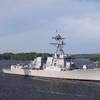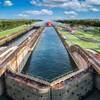Port of NY/NJ Shows Gains in 2001
Larrabee said the New York-New Jersey port outperformed all other North Atlantic ports combined, which reported cargo tonnage declines of 1.3 percent. He said that the New York-New Jersey port saw growth in virtually every sector - containerized cargo, bulk, breakbulk and rail activity.
Port Authority Executive Director Joseph J. Seymour said, "The Port Authority is moving ahead with a program of investments to keep the port a world-class shipping destination. This year alone, we will spend more than $220 million to dredge key harbor channels, improve ship-to-rail services and restore environmentally sensitive wetland areas." Larrabee said, "These numbers also demonstrate that we need to move forward with our investment program to deepen the harbor's channels, expand marine terminal capacity, improve productivity, enhance landside transportation connections and protect the natural resources of our estuary," Mr. Larrabee said. "Our port investment program addresses each of these issues."
During 2001, total loaded and empty container volumes handled at the port's container terminals, measured in 20-foot equivalent units (TEU's), totaled 3,316,275, an 8.7-percent increase over the 3,050,036 TEU's in 2000. Loaded TEU's reported by the Port Import-Export Reporting System (PIERS) were 2,334,393, a 4.2-percent increase over the 2,241,103 loaded TEU's handled in the port in 2000. According to data from the U.S. Bureau of Census, total general cargo rose from 18,756,000 metric tons in 2000 to 19,811,000 metric tons in 2001, a 5.6-percent increase. General cargo exports rose 14.1 percent, from 5,204,000 metric tons in 2000 to 5,940,000 metric tons in 2001. Exports in plastics and machinery accounted for the largest percentage of the increase. General cargo imports rose 2.4 percent from 13,552,000 metric tons in 2000 to 13,871,000 metric tons in 2001. Total bulk cargo grew by 16.7 percent in 2001 to 53,739,000 metric tons compared to 46,061,000 metric tons in 2000. Bulk cargo exports rose an impressive 79 percent from 1,303,000 metric tons in 2000 to 2,333,000 metric tons in 2001. The export of iron and steel rose dramatically in 2001. Bulk imports also grew from 44,758,000 metric tons in 2000 to 53,738,000 metric tons in 2001, a 14.9-percent increase. Increased imports in mineral fuel oil, salt, sulfur, earth and stone all contributed to the increase. Total cargo volumes (bulk and general cargo combined) grew by 13.5 percent, from 64,817,000 metric tons in 2000 to 73,549,000 metric tons in 2001.
The Port Authority's 2002 investment program includes the following components:
· Continued funding of the local share of the federal channel deepening projects, including deepening the Kill van Kull-Newark Bay channels to 45 feet; the Port Jersey and Arthur Kill channels to 41 feet; and begin the harbor-wide 50-foot channel deepening projects.
· New security measures, including improved fencing, gate monitoring and security surveillance equipment.
· Environmental and harbor restoration investments, including preserving environmentally sensitive tracts of land through the Port Authority's Harbor Restoration Program.
Other 2001 trade highlights include:
· Vessel calls in the Port of New York and New Jersey increased by 3.5 percent, from 5,124 cargo vessels in 2000 to 5,302 in 2001.
· The largest import commodities in 2001 were beverages, vehicles and machinery. The top export commodities were waste paper, plastic products and machinery.
· The top five countries for general cargo imports are China, Italy, Germany, France and India.
The top five countries for general cargo exports are China, the United Kingdom, South Korea, India and Germany.












